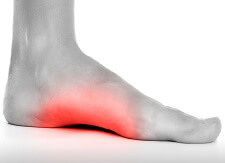- Home
- Diagnosis Guide
- Foot Lumps
- Lump On Bottom Of Foot
Bump On Bottom Of Foot
Written By: Chloe Wilson BSc(Hons) Physiotherapy
Reviewed By: FPE Medical Review Board
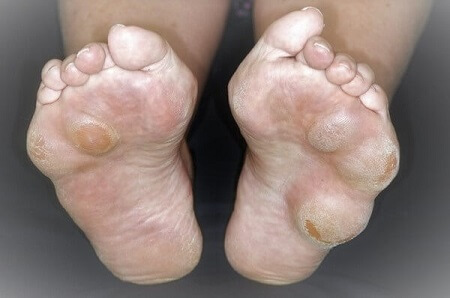
A bump on the bottom of your foot is a common problem that can cause pain or discomfort when walking.
There are lots of possible causes of a lump under the foot including skin problems, joint problems, benign growths and infections.
There may be a hard bump on the bottom of the foot, itchy bumps on the foot, a lump in the arch of the foot or one by the toes.
Treatment for a lump on the bottom of the foot will depend on the underlying cause but may include a combination of orthotics, injections, medications or even surgery. Some foot lumps will resolve by themselves, other will require intervention.
Here we will look at the common causes of a bump on the bottom of the foot, how foot lumps are diagnosed and how best to treat them.
Causes Of Bump On Bottom Of Foot
The most common causes of a bump on the bottom of the foot tend to be:
- On The Skin: e.g. calluses, corns, warts, eczema
- Under The Skin: e.g. fibroma, bursitis, cysts, tumors
- At The Bone: e.g. bone spur, fracture, gout
- In The Soft Tissues: e.g. morton's neuroma, plantar fasciitis
Let’s have a look at the common causes of a lump on the bottom of the foot, how to tell which you have and how to treat them. If you are more bothered by pain than lumps and bumps on the bottom of the foot, check out the Ball Of Foot Pain or Foot Arch Pain articles.
1. Plantar Fibroma
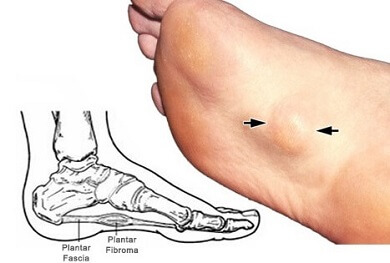
The most common cause of a bump on the bottom of the foot is a plantar fibroma.
Plantar fibromas are small, hard, fibrous nodules that form in the plantar fascia – the thick ligament-like band that runs under the arch of the foot.
A plantar fibroma lump under the foot arch tends to be firm and rubbery and less than an inch wide, most commonly found on the inner side of the sole of the foot. There may be one single lump under the foot or a small cluster of nodules, known as plantar fibromatosis.
A plantar fibroma lump on the bottom of the foot is typically painless, but people often report that it feels like there is a stone in their shoe when they walk.
Plantar fibroma nodules have been linked to foot injuries, certain medical conditions, genetics and gender – men are twice as likely to develop fibromas as women.
To find out more about this hard bump on the bottom of the foot, including causes, symptoms, diagnosis and treatment, check out the Plantar Fibroma article.
2. Calluses
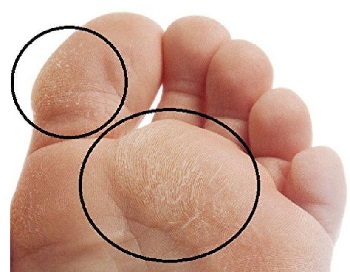
Another common cause of lumps on the bottom of the foot are calluses.
Calluses are areas of thick, hardened skin that can result in bumps under the feet. They often develops around the toes and in the ball of the foot due to repetitive friction from shoes when walking.
Foot callus bumps are particularly common if the foot bones are misaligned as this affects how weight is distributed when you walk e.g. hammertoes, charcot-marie tooth disease and diabetes.
Calluses are not normally painful and are easily treated with a combination of appropriate footwear, creams, pumice stones and orthotics.
You can find out more about how to treat a callus bump on the bottom of the foot in the Foot Calluses section.
3. Bone Spurs
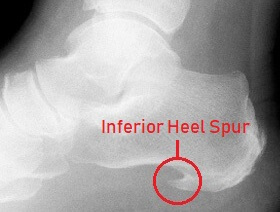
A hard bump on the bottom of the foot or around the heel may be caused by a bone spur.
Bone spurs are caused by abnormal bone growth, usually in response to repetitive friction or stress on one of the foot bones.
Tight footwear, soft tissue tightness, altered foot biomechanics, excessive exercise and foot injuries can all lead to the body laying down excess bone as it tries to protect itself. This can lead to a hard lump on the bottom of the foot, usual on the heel bone e.g. Haglund’s Deformity, or one of the metatarsal bones.
With a bone spur bump on the bottom of foot, it often hurts to walk. People with foot bone spurs often complain of a sharp, stabbing pain under their foot, particularly when they first get up.
A bone spur bump on the bottom of the foot is usually treated with a combination of exercises, orthotics and medication and in some case, surgery may be necessary to remove the hard lump.
You can find out more about how to diagnose and treat a bone spur bump on the bottom of the foot in the Bone Spurs article.
4. Dyshidrotic Eczema
Itchy bumps on the bottom of the foot are often due to dyshidrotic eczema.
Dyshidrotic eczema is thought be caused by allergies or fungal infections. The first symptom is typically intense itching on the sole of the foot and then lots of small bumps on the bottom of the foot develop. The lumps look like tiny, fluid filled blisters and the surrounding skin often flakes or cracks.
You can find out more about these painful, itchy bumps on the bottom of the foot and their causes, symptoms and treatment options in the Foot Eczema section.
5. Morton’s Neuroma
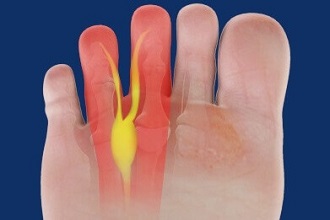
A bump on the bottom of the foot between the middle toes may be due to a Morton’s Neuroma.
A Morton's neuroma is a benign (non-cancerous) growth that develops around the plantar digital nerve of the foot. They typically develop in middle age and are much more common in women than men.
A lump in the ball of the foot caused by a morton’s neuroma typically causes a sharp, stabbing, shooting or burning pain under the foot that spreads to the toes, and there may be tingling and numbness in the ball of the foot.
With a morton’s neuroma, people often complain of a painful bump on bottom of foot that hurts when they walk.
If you suspect the bump on the bottom of your foot is caused by a morton’s neuroma, you can find out all about the causes, symptoms, diagnosis and treatment options in the Morton’s Neuroma article.
6. Plantar Warts
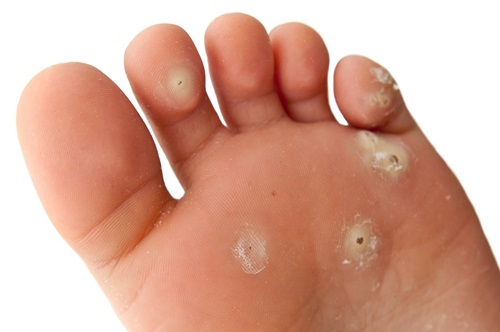
Another common cause of a bump on the bottom of the foot is a plantar wart, aka verruca.
Plantar warts are benign epithelial tumors caused by the HPV virus entering the body through a break in the skin.
Plantar warts cause a small painful bump on the bottom of the foot that is usually skin colored with small, black dots on the surface.
They are notoriously slow to respond to treatment which may consist of regular application of salicylic acid or various creams, cryotherapy, or surgery.
You can find out more about the symptoms and causes of verrucas in the Plantar Warts section.
Other Causes Of Bump Under Foot
There are a number of other things than can also result in a bump on the bottom of the foot including:
- Benign Soft Tissue Tumors: A bump on the bottom of the foot may also be caused by a cyst (small pocket of fluid) or a benign soft tissue tumor e.g. ganglion cyst or lipoma. They tend to be small, soft and slow-growing.
- Ganglion Cyst: A small, soft lump underneath the foot may be a ganglion cyst. Fluid collects around a joint or tendon sheath forming a lump, usually between 1-4cm wide which may or may not cause pain and restrict foot movement
- Sesamoiditis: A painful bump underneath the big toe is often caused by sesamoiditis, where there is inflammation of the the two pea-sized bones that sit directly under the big toe. They tend to be painful when any pressure goes through the big toe e.g. walking, running and jumping.
- Synovial Sarcoma: Whilst most tumors on the bottom of the foot are benign (non-cancerous), they can occasionally be caused by a synovial sarcoma which is malignant. Synovial sarcomas are rare with an incidence of 2.57 per 100,000 people, and typically affects people between the ages of 15-40 years. Any new bump on the bottom of the foot should be examined by your doctor – if they suspect the lump may be cancerous they will take a biopsy.
- Gout: A red, swollen, painful lump on the bottom of the foot by the big toe may be due to gout, where uric acid crystals form in the joint. Gout symptoms tend to develop rapidly with no warning, and repeat episodes are common without effective treatment.
- Plantar Fasciitis: Plantar fasciitis inflammation can cause a generalised bump on the bottom of the foot, usually around the heel bone. And if tightness in the plantar fascia has led to the formation of a calcaneal bone spur, there will be a hard lump on the bottom of the foot. Specific exercises and orthotics can really help to reduce plantar fasciitis pain.
- CMT: Charcot Marie Tooth Disease is one of the more rare causes of a bump on the bottom of the foot. CMT a type of peripheral neuropathy where there is degeneration of the lower limb nerves. This affects the position of the toes and foot arches which can lead to a lump underneath the foot. Clumsiness is one of the first signs of CMT in children and other symptoms include foot cramps, spinal deformity, altered reflexes and difficulty walking.
Diagnosing Lump Under Foot
Any new bump on the bottom of your foot should be checked out by your doctor to ensure an accurate diagnosis.
Your doctor may be able to tell what is causing the lump under your foot from your history and by looking at your foot, but in some cases they may want to send you for further investigations such as an x-ray, MRI scan, CT scan or biopsy.
Treatment for a bump on the bottom of the foot will depend on the underlying cause of the foot arch lump but may include a combination of orthotics, exercises, physical therapy, steroid injections or in some case surgery. You can find out more about the best treatment options for each of the causes of a lump on the bottom of the foot using the links above.
Bumps and lumps can develop anywhere on the feet and you may also be interested in the following articles:
Summary
There are lots of possible causes of a bump on the bottom of the foot that may or may not cause pain.
A lump on the bottom of the foot by your toes is most likely due to a morton’s neuroma, plantar fibroma, sesamoiditis, gout, callus, or a bone spur.
A painful lump under the bottom of the foot may be due to a morton’s neuroma, fibroma, bone spur, ganglion cyst or CMT.
A lump in the arch of the foot is usually caused by a fibroma, plantar fasciitis, ganglion cyst or in rare cases Charcot-Marie-Tooth.
A hard bump on the bottom of the foot that hurts when you walk may be caused by calluses, fibroma, bone spur, neuroma, sesamoiditis or gout.
Treatment will depend on what is causing your foot lump - you can find out about the best treatment options using the links above. And remember, any new bump on bottom of foot should be checked out by your doctor.
You may also be interested in the following articles:
Related Articles
Page Last Updated: 20th November, 2024
Next Review Due: 20th November, 2026
